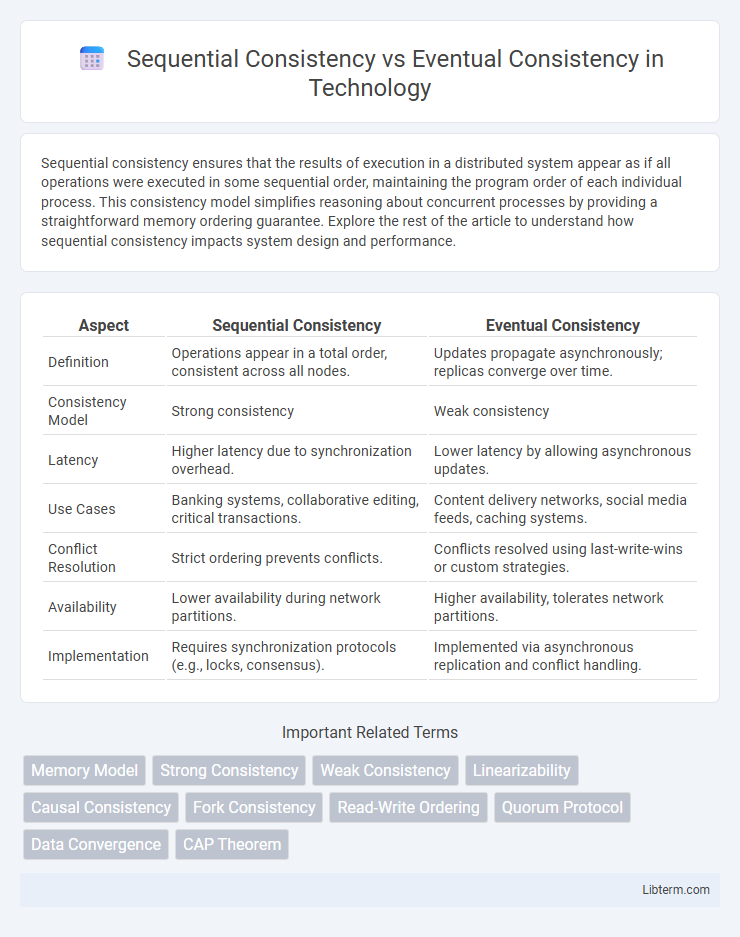Sequential consistency ensures that the results of execution in a distributed system appear as if all operations were executed in some sequential order, maintaining the program order of each individual process. This consistency model simplifies reasoning about concurrent processes by providing a straightforward memory ordering guarantee. Explore the rest of the article to understand how sequential consistency impacts system design and performance.
Table of Comparison
| Aspect | Sequential Consistency | Eventual Consistency |
|---|---|---|
| Definition | Operations appear in a total order, consistent across all nodes. | Updates propagate asynchronously; replicas converge over time. |
| Consistency Model | Strong consistency | Weak consistency |
| Latency | Higher latency due to synchronization overhead. | Lower latency by allowing asynchronous updates. |
| Use Cases | Banking systems, collaborative editing, critical transactions. | Content delivery networks, social media feeds, caching systems. |
| Conflict Resolution | Strict ordering prevents conflicts. | Conflicts resolved using last-write-wins or custom strategies. |
| Availability | Lower availability during network partitions. | Higher availability, tolerates network partitions. |
| Implementation | Requires synchronization protocols (e.g., locks, consensus). | Implemented via asynchronous replication and conflict handling. |
Understanding Data Consistency in Distributed Systems
Sequential consistency ensures that all operations in a distributed system appear to execute in a specific, globally agreed-upon order, preserving the exact sequence of read and write operations across nodes. Eventual consistency, commonly used in distributed databases and cloud services like Amazon DynamoDB and Cassandra, guarantees that, after some undefined delay, all replicas will converge to the same data state without enforcing immediate synchronization. Understanding the trade-offs between sequential consistency's strict ordering and eventual consistency's high availability and partition tolerance is crucial for designing scalable, fault-tolerant distributed systems.
What is Sequential Consistency?
Sequential consistency is a consistency model in distributed systems where the results of execution appear as if operations from all processes were executed in some sequential order, and the operations of each individual process appear in this sequence in the order issued by that process. This model ensures that all processes observe memory operations in a consistent order, maintaining program correctness and predictability. Unlike eventual consistency, sequential consistency provides stronger guarantees by preventing anomalies caused by out-of-order updates or reads.
What is Eventual Consistency?
Eventual consistency is a consistency model used in distributed systems where updates to a data item will propagate to all replicas over time, ensuring that all nodes eventually hold the same value. Unlike sequential consistency, which guarantees a strict order of operations visible to all users, eventual consistency allows temporary divergence but prioritizes availability and partition tolerance. This model is commonly employed in large-scale distributed databases such as Amazon DynamoDB and Apache Cassandra to achieve high scalability and fault tolerance.
Key Differences Between Sequential and Eventual Consistency
Sequential consistency guarantees that operations appear in a strict order consistent across all nodes, ensuring immediate data accuracy but potentially impacting system performance. Eventual consistency allows temporary discrepancies by permitting updates to propagate asynchronously, optimizing availability and responsiveness in distributed systems. The key difference lies in sequential consistency's strict ordering and synchronization versus eventual consistency's relaxed synchronization aiming for eventual convergence.
Pros and Cons of Sequential Consistency
Sequential consistency ensures that operations from all processes occur in a strict order, making system behavior predictable and easier to debug. This strong consistency model simplifies reasoning about concurrent operations but often results in higher latency and reduced system availability due to the need for synchronization. The trade-off limits scalability in distributed systems where low-latency responses and fault tolerance are critical.
Pros and Cons of Eventual Consistency
Eventual consistency offers high availability and low latency by allowing updates to propagate asynchronously, making it ideal for distributed systems with many nodes. However, it can lead to temporary data inconsistencies, which complicate real-time decision-making and require conflict resolution mechanisms. Its pros include scalability and fault tolerance, while the cons involve potential data anomalies and increased complexity in application logic.
Use Cases for Sequential Consistency
Sequential consistency guarantees that all processes see memory operations in the same order, making it ideal for applications requiring strict data consistency such as financial transactions, online banking, and real-time collaborative editing. Distributed systems managing inventory in e-commerce platforms also rely on sequential consistency to prevent conflicts and ensure accurate stock levels. Use cases demanding strong consistency and immediate data reliability benefit significantly from sequential consistency models.
Use Cases for Eventual Consistency
Eventual consistency is ideal for distributed systems requiring high availability and partition tolerance, such as large-scale social media platforms and content delivery networks where immediate synchronization is less critical. Use cases include globally distributed databases, caching systems, and IoT networks where data updates propagate asynchronously to optimize performance and scalability. This model suits scenarios prioritizing low latency and fault tolerance over strict data accuracy at all times.
Impact on System Performance and Scalability
Sequential consistency enforces a strict operation ordering across distributed systems, which can introduce higher latency and reduce throughput due to synchronization overhead, ultimately limiting system scalability under heavy loads. Eventual consistency relaxes ordering guarantees, allowing replicas to update asynchronously and improving system performance by minimizing coordination delays; this approach enhances scalability by enabling systems to handle larger workloads with lower latency. The trade-off between these models involves balancing immediate consistency with system responsiveness and scaling capabilities, where eventual consistency favors performance and scalability in distributed environments.
Choosing the Right Consistency Model for Your Application
Choosing the right consistency model depends on application requirements for data accuracy and availability. Sequential consistency ensures that operations appear in a strict order, providing strong data correctness crucial for banking and inventory systems. Eventual consistency favors system availability and partition tolerance, making it ideal for social media feeds or caching where real-time accuracy is less critical.
Sequential Consistency Infographic

 libterm.com
libterm.com